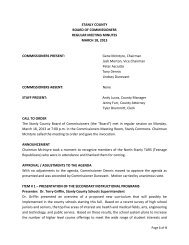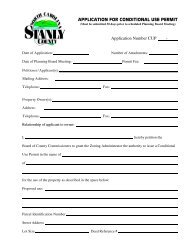Land Use Plan – 2002 - Stanly County, North Carolina
Land Use Plan – 2002 - Stanly County, North Carolina
Land Use Plan – 2002 - Stanly County, North Carolina
You also want an ePaper? Increase the reach of your titles
YUMPU automatically turns print PDFs into web optimized ePapers that Google loves.
Strengths<br />
Weaknesses<br />
Impact Fees<br />
How It Works<br />
STANLY COUNTY<br />
These are based on a series of COCS studies performed by the AFT and the New England<br />
Forest Consortium. Residential uses, because of their high demand on public services, generally<br />
cost municipalities more than they provide in revenues, while other land uses such as<br />
commercial and open spaces generate more revenue than they require in public services.<br />
The following strengths are associated with the performance of a COCS:<br />
This type of analysis can help prepare the community to strategically manage and or<br />
quantify growth based on the real financial costs versus real financial benefits of growth. It<br />
can be used as a preliminary step in the analysis of the feasibility of imposing impact fees to<br />
finance certain types of community services.<br />
This type of analysis can help a community appropriately plan infrastructure investments<br />
based on projected revenues of the individual land uses and to meet future budget<br />
requirements and<br />
The following weaknesses are associated with the COCS process:<br />
Strict use of a COCS may indicate that certain land uses or activities are ideal given the<br />
fiscal ramifications whether or not they are locally desirable and compatible with a plan.<br />
COCS is highly controversial to the development community.<br />
An impact fee is a tool to help a community provide adequate levels of infrastructure for a<br />
growing community. Monetary fees or in-kind donations are paid by a developer to the<br />
municipality, city, or authority charged with managing a public utility or service such as water<br />
distribution or sewer collection and treatment systems. The revenue is then used to pay for<br />
upgrades to infrastructure that are needed to accommodate the additional demands on roads,<br />
parks etc. generated by a new development. Impact fees can be utilized to pay for road<br />
improvements, parkland acquisition, park improvements, utility upgrades, utility line extensions,<br />
schools, and other similar services.<br />
Based on the specific population associated with a new development, an analysis (such as a<br />
COCS as described above) is performed of how roads, parks and schools will be impacted by<br />
the new development. The questions asked include will the increase in traffic require larger<br />
roads and additional turn lanes, is more park land need to be acquired to provide open space<br />
and recreational opportunities, and are new schools required. As these questions are answered,<br />
the costs associated with each various improvement are noted and the developer is required to<br />
compensate the community and place funds in the impact fee accounts. As more and more<br />
development occurs, and the impact fee account balance rises, then the municipality can buy<br />
land needed for the park or pay for the road widening when it is needed.<br />
<strong>Land</strong> <strong>Use</strong> <strong>Plan</strong> 6-27 6/02






